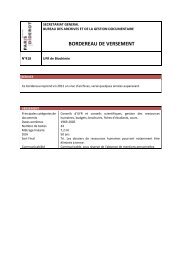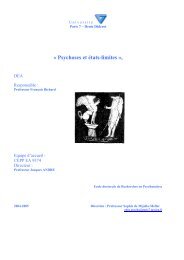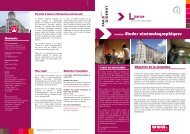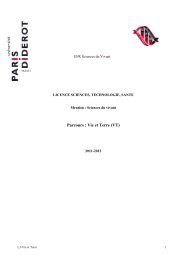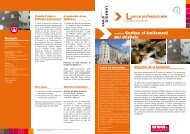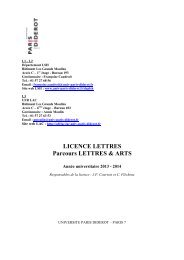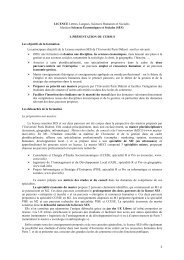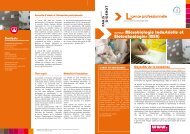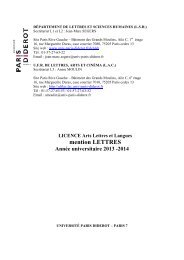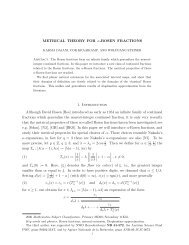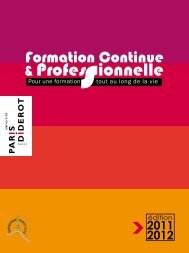Coordinator's names Carole DELPORTE-GALLET Hugues ...
Coordinator's names Carole DELPORTE-GALLET Hugues ...
Coordinator's names Carole DELPORTE-GALLET Hugues ...
You also want an ePaper? Increase the reach of your titles
YUMPU automatically turns print PDFs into web optimized ePapers that Google loves.
5 Consortium description<br />
5.1 Partners description and relevance, complementarity<br />
The consortium gathers members from three French leading labs in Distributed Computing (LIAFA, LaBRI,<br />
and IRISA). Each of these labs has a worldwide reputation of excellence in the design and analysis of<br />
distributed algorithms. DISPLEXITY has paid attention to include experts of most sub-topics in distributed<br />
computing, including network computing, mobile computing, fault-tolerant computing, population protocols,<br />
failure detector theory, etc. In order to illustrate the high level of expertise of the DISPLEXITY partners,<br />
let us just mention that the consortium includes several ACM PODC and DISC Program Committee Chairs<br />
(which are the top Int’l conferences in the domain), several DISC and SIROCCO Steering Committee Chairs,<br />
and regular Program Committee members of most conferences in distributed computing (ACM PODC, DISC,<br />
SIROCCO, OPODIS, SSS, IEEE ICDCS, IPDPS, etc.) and Editorial Board members of top Int’l journals<br />
(e.g., IEEE Transactions on Computers, IEEE Transactions on Parallel and Distributed Systems, Journal of<br />
Parallel and Distributed Computing).<br />
The quality of the consortium is more than the sum of the quality of its members. Indeed, the main<br />
interest of DISPLEXITY will be its ability to tackle the main research models in distributed computing in<br />
parallel. To enable DISPLEXITY to take up the challenges of dealing with apparently so many different computational<br />
models, we have focused our attention on yes/no problems, which will ensure a global coherency<br />
of the project. This apparent narrowing of the problem field is actually not restrictive as it is sufficient for<br />
the development of a complexity theory (this is because such theory is based on decision problems).<br />
As illustrated by the collaborative diagram displayed on Figure 1, the consortium includes two well<br />
identified sub-groups, with each of the sub-groups scattered over the three collaborative institutions LIAFA-<br />
LaBRI and IRISA. Roughly, one sub-group includes individuals dealing with problems related to asynchrony<br />
and faults, while the other one includes partners dealing with network computing.<br />
It should be mentioned that many participants regularly attend to the same conferences gathering both<br />
communities. The high added value brought by DISPLEXITY is to provide a general framework (Computational<br />
Complexity) in which these people will exchange and collaborate. Conversely, the richness of the<br />
consortium, beyond the individual quality of its members, is to gather these two groups together: each one<br />
separately will not be able to cover more than a fragment of the theory. We do hope, and actually strongly<br />
believe, that the same drawing at the end of DISPLEXITY will display a single component, with connecting<br />
edges corresponding to many significative publications in Distributed Computational Complexity.<br />
Bordeaux (LABRI): The LaBRI (Laboratoire Bordelais de Recherche en Informatique) is a research<br />
unit associated with the CNRS (UMR 5800), the University of Bordeaux 1, the IPB and the University<br />
of Bordeaux 2. It has significantly increased in staff numbers over recent years and now includes around<br />
350 members (academics, researchers, PhDs, etc.). Today the members of the laboratory are grouped in<br />
six teams, each one combining basic research, applied research and technology transfer : * Combinatorics<br />
and Algorithmics * Image and Sound * Languages, Systems and Networks * Formal Methods * Models and<br />
Algorithms for Bio-informatics and Data Visualisation * Supports and Algorithms for High Performance<br />
Numerical Applications<br />
The LaBRI participants to DISPLEXITY are all members of the Combinatorics and Algorithmics team<br />
and most of them are in the INRIA team CEPAGE. They are all recognized worldwide experts in distributed<br />
computing. The LaBRI team includes specialists on various models and topics in the scope of the project,<br />
in particular fault tolerance issues, network and communication algorithmics, and (possibly quantum) distributed<br />
information.<br />
Paris (LIAFA): The LIAFA (Laboratoire d’Informatique Algorithmique: Fondements et Applications)<br />
is supported jointly by the French National Center for Scientific Research (CNRS) and by the University<br />
Paris Diderot - Paris 7. It is member of the Fondation Sciences mathématiques de Paris. The main research<br />
topics addressed by LIAFA are related to theoretical computer science. The one hundred members<br />
16



